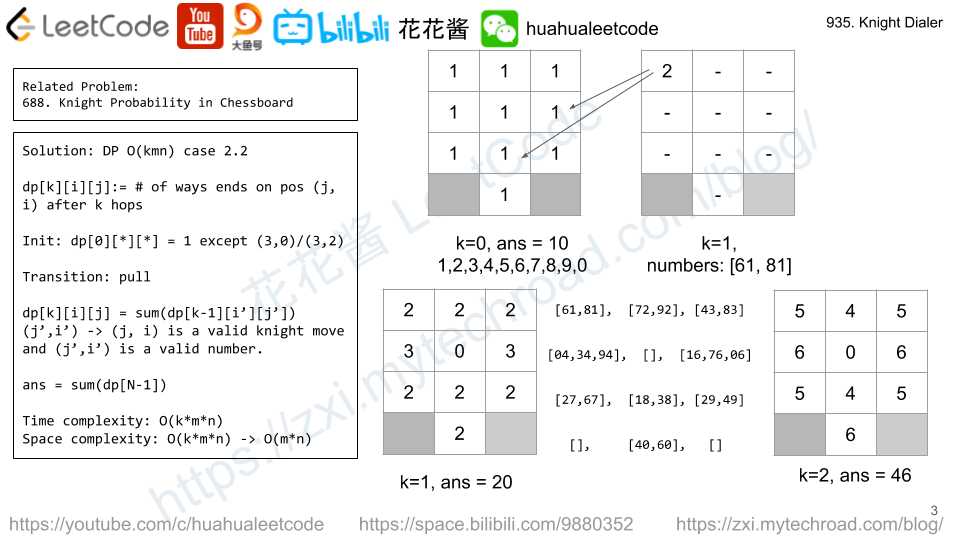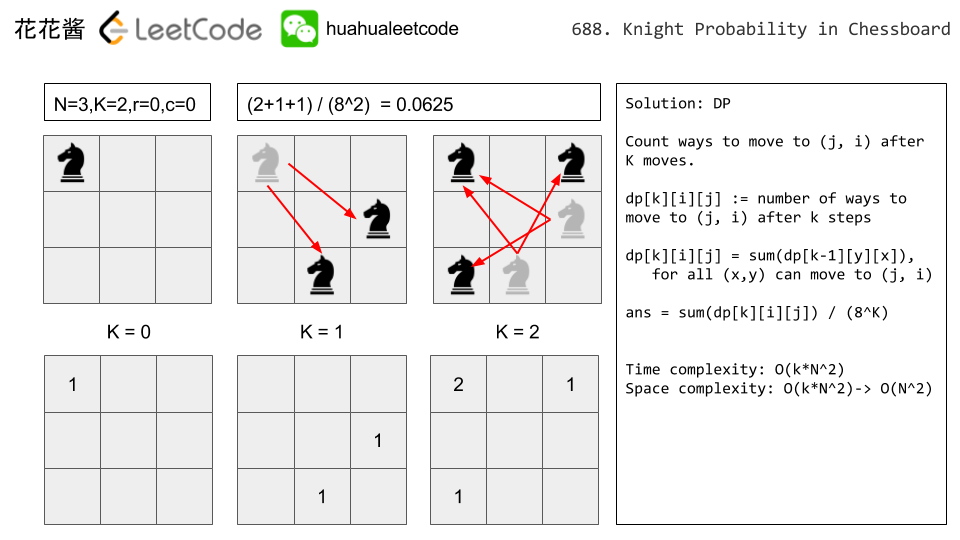Problem
https://leetcode.com/problems/knight-dialer/description/
A chess knight can move as indicated in the chess diagram below:
 .
. 
This time, we place our chess knight on any numbered key of a phone pad (indicated above), and the knight makes N-1 hops. Each hop must be from one key to another numbered key.
Each time it lands on a key (including the initial placement of the knight), it presses the number of that key, pressing N digits total.
How many distinct numbers can you dial in this manner?
Since the answer may be large, output the answer modulo 10^9 + 7.
Example 1:
Input: 1 Output: 10
Example 2:
Input: 2 Output: 20
Example 3:
Input: 3 Output: 46
Note:
1 <= N <= 5000
Solution: DP
V1
Similar to 花花酱 688. Knight Probability in Chessboard
We can define dp[k][i][j] as # of ways to dial and the last key is (j, i) after k steps
Note: dp[*][3][0], dp[*][3][2] are always zero for all the steps.
Init: dp[0][i][j] = 1
Transition: dp[k][i][j] = sum(dp[k – 1][i + dy][j + dx]) 8 ways of move from last step.
ans = sum(dp[k])
Time complexity: O(kmn) or O(k * 12 * 8) = O(k)
Space complexity: O(kmn) -> O(mn) or O(12*8) = O(1)
V2
define dp[k][i] as # of ways to dial and the last key is i after k steps
init: dp[0][0:10] = 1
transition: dp[k][i] = sum(dp[k-1][j]) that j can move to i
ans: sum(dp[k])
Time complexity: O(k * 10) = O(k)
Space complexity: O(k * 10) -> O(10) = O(1)
C++ V1
|
1 2 3 4 5 6 7 8 9 10 11 12 13 14 15 16 17 18 19 20 21 22 23 24 25 26 27 28 29 |
// Author: Huahua, 96 ms class Solution { public: int knightDialer(int N) { constexpr int kMod = 1e9 + 7; int dirs[8][2] = {{-2, -1}, {-2, 1}, {-1, -2}, {-1, 2}, {1, -2}, {1, 2}, {2, -1}, {2, 1}}; vector<vector<int>> dp(4, vector<int>(3, 1)); dp[3][0] = dp[3][2] = 0; for (int k = 1; k < N; ++k) { vector<vector<int>> tmp(4, vector<int>(3)); for (int i = 0; i < 4; ++i) for (int j = 0; j < 3; ++j) { if (i == 3 && j != 1) continue; for (int d = 0; d < 8; ++d) { int tx = j + dirs[d][0]; int ty = i + dirs[d][1]; if (tx < 0 || ty < 0 || tx >= 3 || ty >= 4) continue; tmp[i][j] = (tmp[i][j] + dp[ty][tx]) % kMod; } } dp.swap(tmp); } int ans = 0; for (int i = 0; i < 4; ++i) for (int j = 0; j < 3; ++j) ans = (ans + dp[i][j]) % kMod; return ans; } }; |
C++ V2
|
1 2 3 4 5 6 7 8 9 10 11 12 13 14 15 16 17 18 19 |
// Author: Huahua, 24 ms public: int knightDialer(int N) { constexpr int kMod = 1e9 + 7; vector<vector<int>> moves{{4,6},{8,6},{7,9},{4,8},{3,9,0},{},{1,7,0},{2,6},{1,3},{2,4}}; vector<int> dp(10, 1); for (int k = 1; k < N; ++k) { vector<int> tmp(10); for (int i = 0; i < 10; ++i) for (int nxt : moves[i]) tmp[nxt] = (tmp[nxt] + dp[i]) % kMod; dp.swap(tmp); } int ans = 0; for (int i = 0; i < 10; ++i) ans = (ans + dp[i]) % kMod; return ans; } }; |

 Each time the knight is to move, it chooses one of eight possible moves uniformly at random (even if the piece would go off the chessboard) and moves there.
Each time the knight is to move, it chooses one of eight possible moves uniformly at random (even if the piece would go off the chessboard) and moves there.